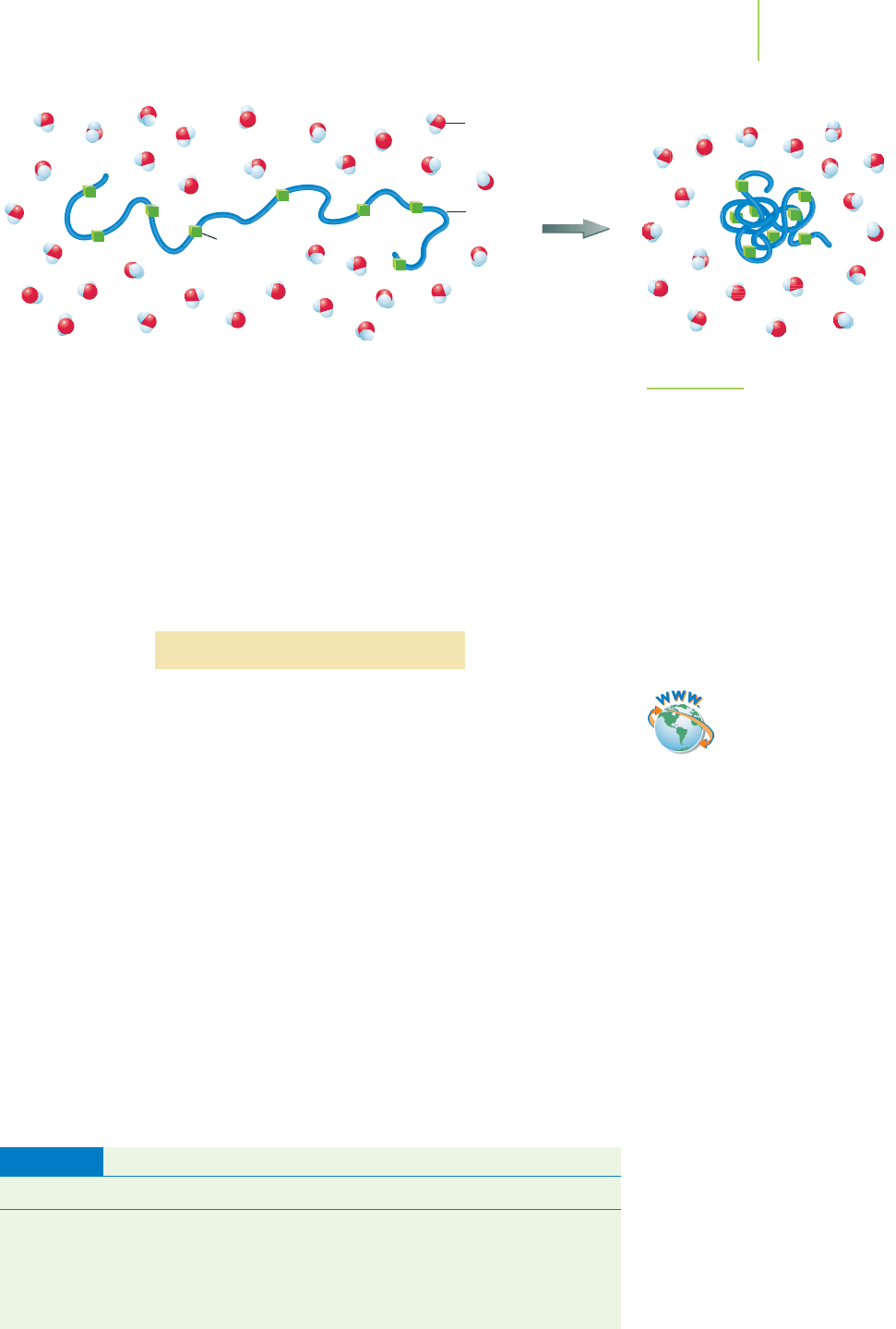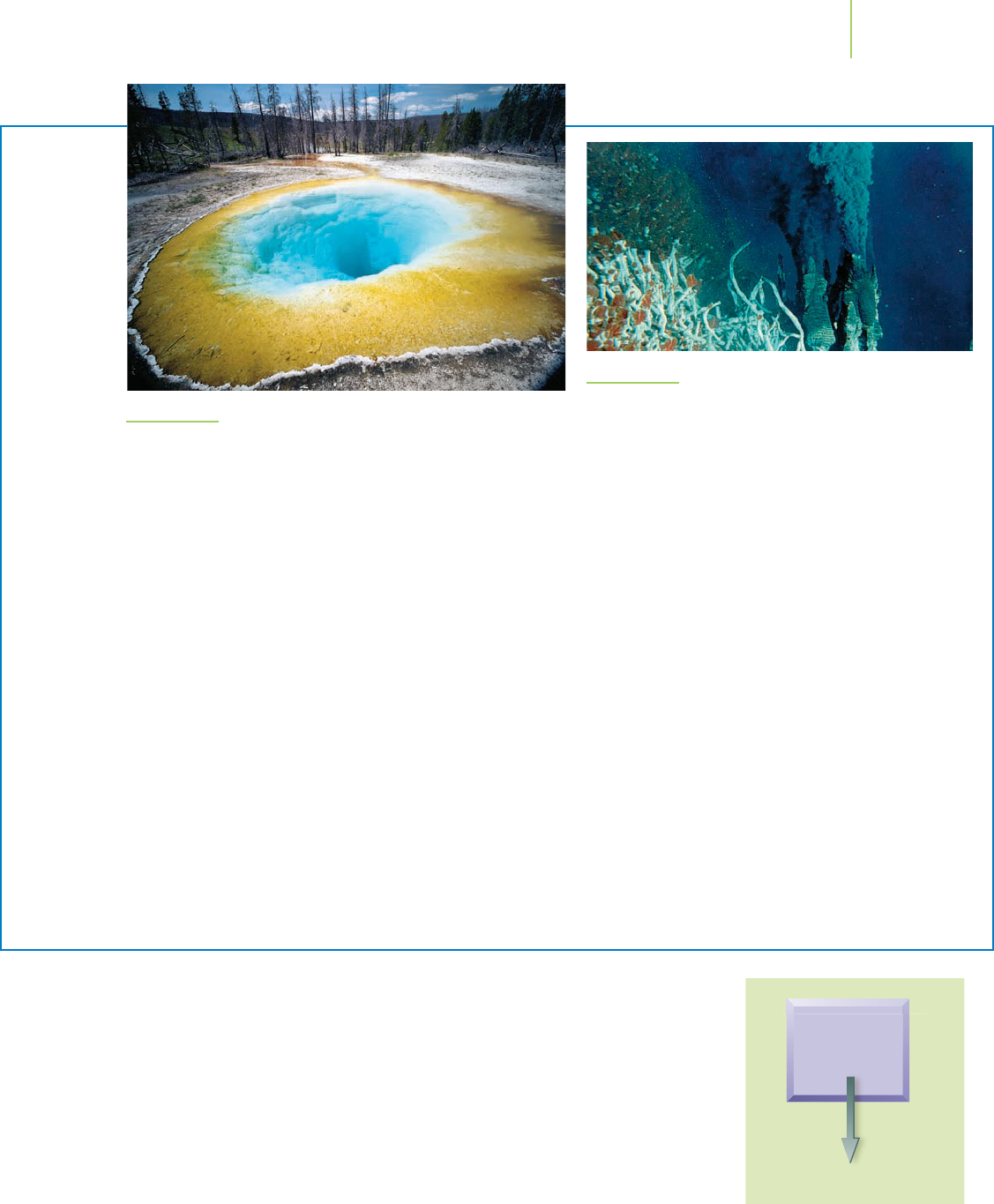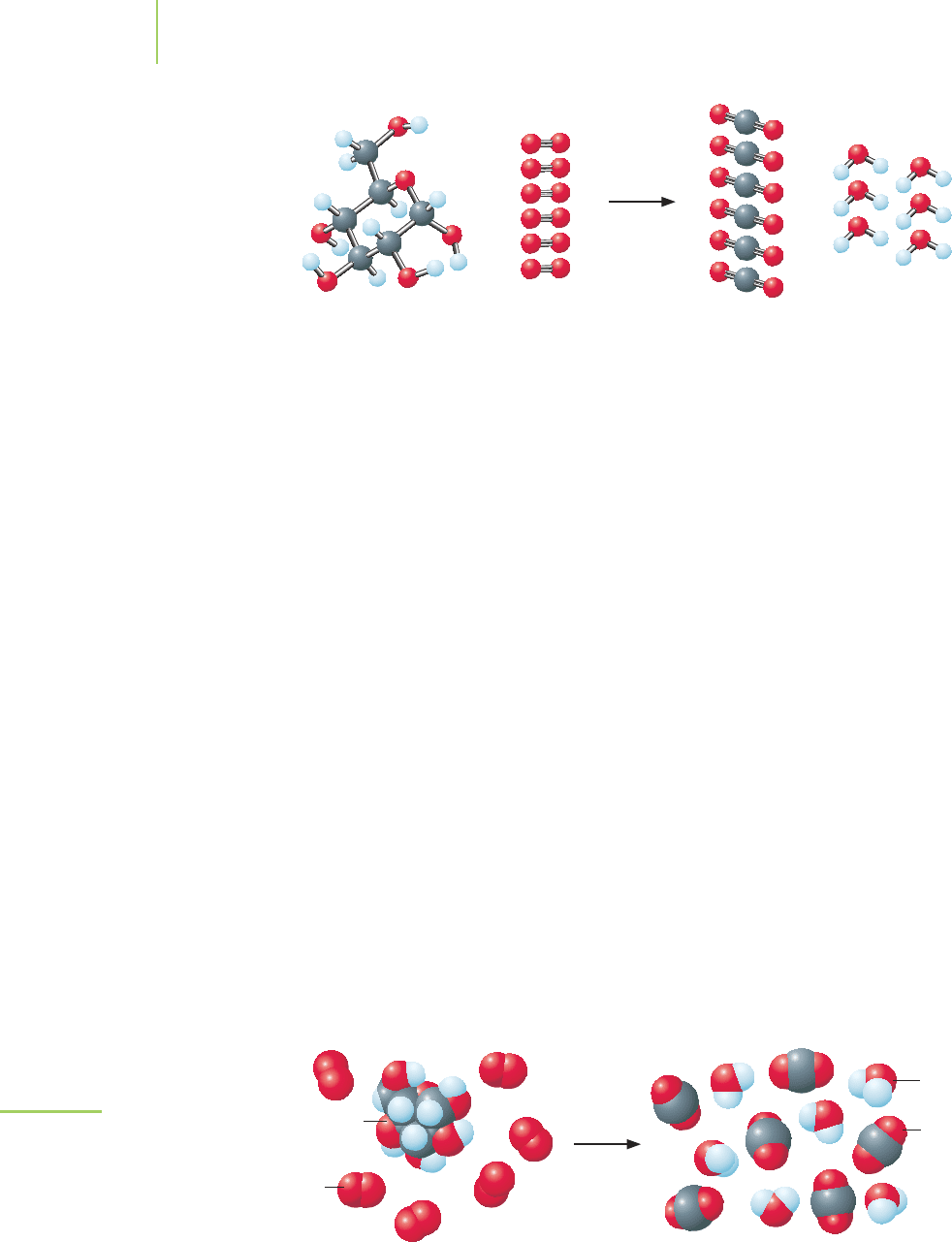Kelter P., Mosher M., Scott A. Chemistry. The Practical Science
Подождите немного. Документ загружается.


which energy and matter can be distributed also increases. Proba-
bility predicts that if the multiplicity of the system increases, there
should be a corresponding increase in the number of ways in which
energy and matter can be distributed in the system. This growth in
the number of microstates increases the entropy of a system. In
other words, the more probable outcome of a spontaneous process is
that an increase in entropy occurs.
We can perform a simple experiment to help explain entropy.
Say we have a friend place a bottle of perfume at one end of a room
while we sit blindfolded in a chair on the opposite side of the room,
as illustrated in Figure 14.11. Our friend opens the bottle. Still
blindfolded, can we tell that the bottle has been opened? At first we
would say it is still closed. Given a little time, though, we begin to
notice the fragrance of the perfume and conclude that the bottle
was opened. Why do we smell the perfume? The fragrance was
released from the bottle on the opposite side of the room, so
shouldn’t it remain near the opened bottle? You know from experi-
ence that this isn’t the case. What causes the perfume molecules to
diffuse throughout the room and, eventually, into the noses of peo-
ple at its most distant points? There is no pressure difference across the room, but
still the perfume mixes spontaneously with the air. We can assume from the ki-
netic molecular theory that the attractive forces between the molecules of per-
fume and of those in the air are negligible, so there should be no significant
change in the enthalpy of the process. Diffusion is neither exothermic nor en-
dothermic for ideal gases. Instead, diffusion increases the distribution of the mol-
ecules throughout the room. Diffusion also increases the distribution of energy.
The entropy of the system has increased.
We need to be extremely careful when we think of entropy. In processes repre-
sented by the perfume experiment, it appears that the level of disorder of the
molecules has increased. Sometimes, we incorrectly think of entropy as a measure
of the disorder of a system. But even though the increase in entropy often paral-
lels the increase in disorder, entropy is not a measure of how disorganized a
system has become. Disorder is a macroscopic description of a system, whereas
entropy is related to the number of microstates.
The Second Law
Inside the cells of your body lie the enzymes (polymers of amino acids; see Chap-
ter 12) that release energy from glucose. As shown in Figure 14.12, these large
polymers start out as long flexible strands but, shortly after being made, fold into
a small globular shape that contains pockets for binding glucose, ATP, ADP, water,
and other compounds. The structure and type of amino acids around the bind-
ing pockets determine what type of reaction the enzyme will catalyze. Protein
folding into the correct shape is a spontaneous process.
Does this make sense? The
flexible extended chain has many more motions than the folded enzyme; the
number of ways to distribute energy in the system decreases as the enzyme folds.
On the basis of this information alone, we might predict that protein folding is
nonspontaneous. A closer look reveals our need for a deeper understanding of
entropy and spontaneity.
As a rule, we say that a spontaneous process is accompanied by an increase in
the entropy of the universe. This is the
second law of thermodynamics. Mathemat-
ically, the change in the entropy of the universe is greater than zero for a sponta-
neous process:
∆S
universe
> 0
588 Chapter 14 Thermodynamics: A Look at Why Reactions Happen
Increase in entropy
FIGURE 14.11
An experiment to explain entropy. Diffusion of gases is
driven by entropy.
Application

∆S
universe
Is the Sum of ∆S
system
and ∆S
surroundings
∆S
surroundings
∆S
system
∆S
universe
Spontaneity
+++Spontaneous
+−? Spontaneous if ∆S
system
< ∆S
surroundings
−+? Spontaneous if ∆S
system
> ∆S
surroundings
−−−Nonspontaneous
TABLE 14.2
Water
Protein
Nonpolar
group
FIGURE 14.12
The folding of proteins is driven by
entropy. The unfolded protein (a) disrupts
the interactions of the water mole-
cules. The nonpolar groups are tucked
inside the protein, removing them from
interaction with the solvent (b). The fold-
ing also increases the intermolecular
forces of attraction between different
regions of the protein and increases the
number of interactions between solvent
molecules.
However, recall the first law of thermodynamics (from Chapter 5), which says
that the energy of the universe is constant (∆E
universe
= 0). This contrasts with the
second law, which implies that the entropy of the universe constantly increases. In
other words, the number of possibilities for the distribution of the energy and
matter of the universe constantly increases. This increase is related to the entropy
changes in the system and surroundings (see Chapter 5 if you wish to review our
definitions of the terms universe, system, and surroundings). Because the total en-
tropy of the universe is the sum of the change in entropy for a particular system
(∆S
system
) and the change in entropy of the surroundings (∆S
surroundings
), we can
describe the change in entropy of the universe as follows:
∆S
universe
= ∆S
system
+ ∆S
surroundings
■
If ∆S
universe
> 0, the process is spontaneous.
■
If ∆S
universe
< 0, the process is nonspontaneous and is the reverse of the spon-
taneous process.
■
If ∆S
universe
is zero, we say that the process is neither spontaneous nor
nonspontaneous but is at equilibrium, a condition of energetic stability that
we will discuss shortly.
Because we take the sum of the change in entropy of the system and the change
in entropy of the surroundings to obtain the change in entropy of the universe,
∆S
system
could be a negative number and the overall process could still remain
spontaneous. For example, if ∆S
system
= –50 J/K·mol and ∆S
surroundings
=+80 J/
mol·K, then
∆S
system
+ ∆S
surroundings
= ∆S
universe
−50 J/mol·K + (+80 J/mol·K) =+30 J/mol·K
In this case, ∆S
surroundings
increases more than ∆S
system
decreases, so ∆S
universe
in-
creases and the process is spontaneous. Table 14.2 outlines the effects of ∆S
universe
as a function of the change in entropy of the system and surroundings. Pick some
14.2 Why Do Chemical Reactions Happen? Entropy and the Second Law of Thermodynamics 589
(a) (b)
Visualization: Spontaneous
Reactions

590 Chapter 14 Thermodynamics: A Look at Why Reactions Happen
The protein resides
in a “pocket” of space.
The folded protein has
smaller disruptions of
solvent–solvent interactions.
Water
FIGURE 14.13
The unfolded protein reduces the inter-
actions of the solvent molecules. By fold-
ing, it allows those favorable interac-
tions to take place.
sample values for ∆S
system
and ∆S
surroundings
, as we did just above, to help clarify
the outcomes in the table.
In the case of our folding protein, we must take into account the entropy of
the system and that of the surroundings if we are to properly assess the change in
entropy of the universe and determine whether the process is spontaneous. As an
extended chain, the enzyme’s nonpolar groups must interact with the aqueous
cellular environment—the surroundings—as shown in Figure 14.13. The un-
folded enzyme disrupts many of the interactions that occur among the solvent
molecules (water). To reduce those disruptions within the surroundings, the
folding enzyme tucks its nonpolar groups into the center of the globular struc-
ture, effectively removing their interaction with the water inside the cell. The
folding allows the polar groups in the enzyme to interact with the polar water
molecules in the surroundings. The water molecules are also able to interact with
each other with minimal disruption. The number of microstates for the protein
decreases during the process of folding, but the number of microstates for the
water and the water–protein interaction increases. The result is a
S
surroundings
that is more positive than the negative S
system
. And the overall process, the fold-
ing of a protein, is spontaneous (
S > 0).
EXERCISE 14.3 Reaction Spontaneity
Determine whether the values shown below will produce a spontaneous process.
S
system
= 140 J/mol·K; S
surroundings
= –155 J/mol·K
Solution
In a spontaneous process the entropy of the universe increases, so we must add the
values for the system and surroundings to answer the question.
S
universe
= S
system
+ S
surroundings
= 140 J/mol·K +(−155 J/mol·K)
=−15 J/mol·K

Because our calculated value for the entropy of the universe is negative, the process
is nonspontaneous.
PRACTICE 14.3
Determine whether the values for entropy in each of these cases will produce a
spontaneous process.
a. S
system
=−23 J/mol·K; S
surroundings
= –55 J/mol·K
b. S
system
= 38 J/mol·K; S
surroundings
= 59 J/mol·K
c. S
system
=−84 J/mol·K; S
surroundings
= 132 J/mol·K
See Problems 17, 18, 29, and 30.
14.3 Temperature and Spontaneous Processes
Living organisms have been found all over the Earth, from the mouths of near-
boiling geysers to the depths of the Arctic Ocean. These living organisms, just like
the species that live near the tropics, require energy to survive. Many of them
use glucose as a source of energy. In fact, some of the psychrotrophs (bacteria
that can survive exposure to low temperatures) and psychrophiles (bacteria that
thrive in low temperatures) employ a concentrated solution of glucose as an
“antifreeze” because such a solution lowers their freezing point. Research by
microbiologists and biochemists into the life processes of the psychrophiles indi-
cates that these organisms, like a lot of other living things on the planet, break
down glucose to produce energy through glycolysis. Does the temperature at
which these organisms live affect the spontaneity of the reactions involved in
glycolysis? To answer this question, we need to consider the signs on the change
in entropy of the system (∆S
system
) and of the surroundings (∆S
surroundings
). A
positive change in the entropy of the universe is required for the process to be
spontaneous.
In general, as compounds undergo changes in their physical states from solid
to liquid to gas, the entropy of the system increases (∆S
system
=+), as shown in
Figure 14.16. Water molecules in an ice cube have a well-defined order in an ice
cube. As the ice begins to melt, this well-defined order disappears and the water
molecules increase their range of motions and, therefore, the number of mi-
crostates. The number of microstates that are possible in the liquid water suggests
that the melting of ice corresponds to an increase in the entropy of the system.
The same holds true when water is con-
verted into steam. Conversely, the reverse
of these processes (gas to liquid to solid)
is typically accompanied by a loss of
entropy (∆S
system
= –).
What is the effect of energy transfer
on ∆S? When steam condenses to liquid
water, energy as heat flows out of the sys-
tem and into the surroundings, and the
kinetic energy of the particles in the sur-
roundings increases. The motions of the
atoms in the surroundings increase, and
the sign of ∆S
surroundings
is positive. On
the other hand, if energy as heat flows
from the surroundings to the system
(liquid to vapor), we’d expect the kinetic
14.3 Temperature and Spontaneous Processes 591
Application
C
HEMICAL ENCOUNTERS:
Psychrotrophs and
Psychrophiles
Water molecules gain increased
freedom of motion in changing
phase from solid to liquid.
Video Lesson: Entropy and
Temperature

592 Chapter 14 Thermodynamics: A Look at Why Reactions Happen
Imagine living at the bottom of the Arctic Ocean, think-
ing life was grand inside glacial ice, enjoying the weather
near a thermal vent, or relaxing under the crush of 1 mile
of bedrock. These conditions sound fairly extreme to us,
but not to a class of bacteria known as the extremophiles.
Some of these microorganisms thrive near the hot bub-
bling mud-pots of Yellowstone National Park, others in
the sulfur-laden waters near a geothermal vent at the bot-
tom of the Atlantic Ocean. Extremophiles, some examples
of which are listed in Table 14.3, survive in conditions
that we humans would find extreme.
Biochemists, microbiologists, and geologists from
around the world study these creatures because of the ex-
treme conditions in which they live and to learn more
about the enzymes that continue to work under the
equally extreme conditions inside them. For instance,
millions of Americans are lactose-intolerant and have
difficulty digesting the lactose in almost every dairy prod-
uct, including milk and ice cream. Imagine if you could
isolate beta-galactosidase (an enzyme that breaks down
sugars like lactose into more easily digested compounds)
from an extremophile that lived in icy environments. The
extremophile’s beta-galactosidase should be capable of
working quite well in cold environments. By adding the
isolated beta-galactosidase to milk and related products
like ice cream, you could make lactose-free dairy products
without having to heat them. Researchers at Pennsylvania
State University have been able to show that this is possi-
ble by isolating a strain of bacteria, known as Arthrobacter
psychrolactophilus that has a modified beta-galactosidase
that works best when the temperature is 15°C and contin-
ues to work well when the temperature is as low as 0°C.
Thomas D. Brock isolated the first example of a true
extremophile from hot springs, such as that shown in
Classes of Extremophiles
Class Extreme Environment Locations Where They Live
Acidophiles Low pH Sulfurous springs and acid mine drainage
Alkaliphiles High pH Alkaline lakes and basic soils
Anaerobes Non-oxygen-containing environments Fermenting juices
Barophiles High pressure Deep sea vents and deep within the Earth
Copiotrophs High nutrient levels Sugar solutions
Halophiles High ion concentration Saline lakes and salt deposits
Hyperthermophiles Temperatures above 70°C Hydrothermal vents, hot springs
Methanogens Methane-rich Deep-sea vents, oil deposits
Oligotrophs Low nutrient levels Desert, rocks
Psychrophiles Low temperatures, typically below 10°C Glaciers, Arctic Ocean, cold soils
Thermophiles Temperatures above 50°C Hydrothermal vents, hot springs
TABLE 14.3
NanoWorld / MacroWorld
Big effects of the very small:
Industrial uses for the extremophiles
S
solid
< <<<S
liquid
S
gas
FIGURE 14.16
Entropy increases as a compound changes
state from solid to liquid to gas. Note that
the increased molecular motions allow more
microstates to exist in the compound.

14.3 Temperature and Spontaneous Processes 593
animal as an aid in digesting food. Their use would im-
prove the usefulness of cheap food as a source of energy
for the animals. The alkaliphiles (base-tolerant bacteria)
thrive in basic soils such as those in the western United
States and in Egypt. Proteases (enzymes that break down
proteins) and lipases (enzymes that break down oils) iso-
lated from these bacteria could find potential use in the
detergent industry. Their addition to laundry detergents
(which typically are basic) would improve the ability of
the detergent to clean stains from clothing.
Investigators are currently searching, and finding,
bacteria that live in environments we originally thought
were sterile. After determining the types and properties
of the enzymes that these bacteria possess, scientists are
exploiting their industrial utility. The uses of these en-
zymes as catalysts to aid human life are endless. Will we
find extremophiles that proliferate on Mars? . . . on Io, the
volcanic innermost major moon of Jupiter? . . . on our
own Moon? And, if so, what uses might we find for the
enzymes they produce?
FIGURE 14.14
The Morning Glory Pool atYellowstone National Park is named for the
brightly colored thermophiles that flourish in this high-temperature
environment.
FIGURE 14.15
Hydrothermal vent in the North Pacific west of Vancouver Island
on the Juan de Fuca Ridge. Extremophiles such as Pyrolobus
fumarii and Methanopyrus live on the sides of these chimneys.
The “smoke” flowing from the vents is actually made up of
minerals from the lava under the ocean floor.
Figure 14.14, in Yellowstone National Park in Wyoming.
This bacterium, called Thermus aquaticus, grows most
rapidly at temperatures near 70°C. Other thermophiles,
or heat-loving bacteria, include Sulfolobus acidocaldarius,
which lives in sulfur-laden hot springs at temperatures as
high as 85°C, and Pyrolobus fumarii, which is isolated
from deep-sea hydrothermal vents (Figure 14.15), grows
only at temperatures above 90°C, and reproduces best at
105°C). These bacteria are of industrial interest because
of their ability to grow at such high temperatures. For ex-
ample, the enzyme Taq polymerase (isolated from T.
aquaticus) is used in DNA fingerprinting because it can
survive the severe temperature variations in the poly-
merase chain reaction used to make multiple copies of
purified DNA (see Chapter 22).
The acid-tolerant extremophiles (acidophiles) are of
interest because their enzymes are capable of operating in
highly acidic environments. A potential application for
the acidophile’s enzymes is their addition to cattle feed,
because they would work well in the acidic gut of an
energy of the particles in the surroundings to decrease and the motions of the
atoms (and, therefore, the entropy) in the surroundings to decrease also. In short,
a flow of energy as heat out of the system and into the surroundings (an exothermic
process) corresponds to a positive sign for ∆S
surroundings
. An endothermic process
has an opposite effect on the surroundings; endothermic processes correspond
to a negative sign for ∆S
surroundings
.
What is this exchange of energy to which we refer? If our process occurs under
reversible conditions at a constant pressure, we can relate the energy of the
process (q
rev
) to the change in enthalpy of the process (∆H). Reversible conditions
occur when the process is allowed to proceed in infinitesimally small steps. At any
point during the reaction, we could change the direction of the reaction with
Energy
System
Surroundings
Exothermic processes involve the
transfer of energy from the system
to the surroundings.

merely slight modifications. Often, reversible conditions exist during phase changes.
Quantitatively, we can summarize our statements by saying that the change in the
entropy is equal to the change in enthalpy of the phase change (a reversible
process) divided by the temperature:
S
system
=
q
rev
T
=
H
system
T
where the temperature (T) is reported in kelvins (K) and the enthalpy (∆H
system
)
is reported in joules per mole. Because of some assumptions we’ve made to arrive
at this equation, its use is limited to describing heat transfers when the tempera-
ture remains constant. For example, the equation works well for describing phase
transitions but poorly for describing a reaction.
Because q
surroundings
=–q
system
, and q
system
=∆H
system
, the value of ∆S
surroundings
can be obtained using a similar equation.
S
surroundings
=
−H
system
T
EXERCISE 14.4 Entropy Change at a Phase Change
Instead of carrying water in their backpacks, hikers can melt ice to make drinking
water. They
also boil water for drinking and food preparation. What is the en-
tropy change of the system for melting 1 mol of ice at 0.00°C and 1 atm? What
is the entropy change for melting 125 g of ice? The enthalpy of fusion at this
phase change,
fus
H is 6.01 kJ/mol.
H
2
O(s) n H
2
O(l)
fus
H = 6.01 kJ/mol at 0.0°C
First Thoughts
The entropy change for the system or surroundings can be calculated if we know the
temperature and the enthalpy of the system. Because the units of entropy are usu-
ally reported in J/mol·K, we should convert the units for the enthalpy and the tem-
perature to match, so our calculation is simplified. The second part of the question
asks us to examine the specific entropy change for a quantity of water that is not
equal to 1 mol. We may do this part of the calculation by dimensional analysis.
Solution
The change in the entropy of this reversible process can be calculated using the
formula we just discussed. This process involves an increase in the entropy of
the system.
S
system
=
H
system
T
=
6010 J/mol
273 K
= 22.0 J/mol·K
We’ve calculated the change in entropy (S = 22.0 J/mol·K) for the
phase change, so we can use this value to determine the change in en-
tropy for melting 125 g of water.
S
system
= 125 g ×
1 mol
18.02 g
×
22.0J
mol·K
=
153 J
K
Further Insights
Reactions can occur with either an increase or a decrease of entropy.
It is interesting to note that this change is based on the number of
moles of the compounds in the reaction. If this relationship appears
594 Chapter 14 Thermodynamics: A Look at Why Reactions Happen
Melting ice into water.

to be similar to what we observed in our discussion of enthalpy in Chapter 5, it
should. Also, as we’ll see later, entropy can be manipulated in ways that are very sim-
ilar to those we used for enthalpy.
Moreover, because the temperature remains constant, we can calculate the value
of S
surroundings
. We find that the value is –22.0 J/mol·K. Therefore, the entropy
change for the universe (S
universe
) should be 0.0 J/mol·K (S
universe
= S
system
+
S
surroundings
). This process is neither spontaneous nor nonspontaneous. It is
reversible.
PRACTICE 14.4
Calculate S
system
for each of these processes at 25°C. Assume that each is a re-
versible process.
I
2
(g) n I
2
(s)
sub
H =+62.4 kJ
H
2
O(l) n H
2
O(g)
vap
H =+40.7 kJ
See Problems 35 and 36.
HERE’S WHAT WE KNOW SO FAR
■
Spontaneous processes are associated with an increase in the entropy of the
universe.
■
The rate of a spontaneous reaction is not related to its spontaneity.
■
The reverse of a spontaneous process is a nonspontaneous process.
■
The change in entropy of the universe can be calculated as the sum of the
change in entropy of the system and the change in entropy of the sur-
roundings.
■
The entropy of the system can be calculated for reversible processes by divid-
ing the enthalpy for the process by the temperature of the process.
14.4 Calculating Entropy Changes
in Chemical Reactions
Metabolism (the biochemical reactions of an organism) releases energy. In this
process, the potential energy stored in food is used by an organism, and some of
the food is converted via chemical reactions into molecules that are needed for
the organism to survive. All of these reactions are spontaneous in the body and
vital to the living processes that occur at the cellular level. For instance, the body
breaks down sucrose, perhaps contained in a sugar-laden gumdrop, into glucose
and fructose. The glucose then enters a series of reactions, the glycolytic pathway
being the first (Figure 14.9), as the body converts it into carbon dioxide and
water. Along the way it produces ATP (Figure 14.10), a molecule used to store po-
tential energy. Plants, on the other hand, synthesize glucose by combining carbon
dioxide and water. This reaction is energetically uphill for the plant, so it uses the
high-energy ATP molecule to drive the reaction to completion. Why is the break-
down of glucose energetically downhill, whereas the formation of glucose is up-
hill? In other words, why does it take energy to make glucose, and why is energy
released when glucose is broken down? We can answer this question by examin-
ing the entropy changes in the combustion of glucose. Qualitatively, is the sign of
14.4 Calculating Entropy Changes in Chemical Reactions 595
Application
C
HEMICAL
ENCOUNTERS:
More Glycolysis

596 Chapter 14 Thermodynamics: A Look at Why Reactions Happen
∆S
system
positive or negative? The reactants include 1 mol of glucose molecules
and 6 mol of gaseous oxygen molecules.
C
6
H
12
O
6
(s) + 6O
2
(g) n 6O
2
(g) + 6H
2
O(g)
The combustion proceeds as 7 mol of reactants are converted into 12 mol of
products (6 mol of gaseous carbon dioxide and 6 mol of gaseous water). Prior to
the reaction, there were a large number of possible microstates because of the
large number (7 mol) of reactants. Because gases occupy a larger volume in a
flask than do equivalent quantities of solids, the 6 mol of oxygen in our reaction
occupy the majority of the locations within the flask as they rapidly travel within
it. After the reaction, there are 12 mol of gas inside the flask. The number of mi-
crostates increased because of the larger number of gaseous products. The in-
crease in the number of microstates is an increase in the entropy of the system
(∆S
system
is positive), as shown in Figure 14.17. If we examine the reverse of this
reaction (from the viewpoint of the glucose-producing plant), the entropy of the
system is lowered because we are combining 12 mol of gaseous carbon dioxide
and water to make 6 mol of gaseous oxygen and 1 mol of solid sugar.
What we’ve discussed is a method by which one can usually predict the sign of
the entropy change accurately. As a rule, the change in entropy of a reaction is pos-
itive if the number of gaseous molecules increases. Although the number of moles of
solid and liquid molecules contributes to the overall number of microstates, the
large volume occupied by gaseous molecules contributes much more. By simply
examining a reaction, we can predict the entropy change. The change is much
harder to assess for reactions that do not involve gaseous molecules.
++
The reaction of glucose with oxygen
generates carbon dioxide and water.
Compare the number of molecules of
gaseous products made to the number
of molecules of gaseous reactants.
O
2
C
6
H
12
O
6
CO
2
H
2
O
C
6
H
12
O
6
(s) + 6O
2
(g) 6CO
2
(g) + 6H
2
O(g)
→
S
reactants
< S
products
FIGURE 14.17
An increase in the number of gaseous
molecules increases the entropy of the
system.

EXERCISE 14.5 Predict the Sign
1. Some camp stoves use butane as fuel. The combustion of butane is exothermic,
providing heat to cook food and boil water. Predict the sign of S
system
for the
combustion of butane.
2CH
3
CH
2
CH
2
CH
3
(g) + 13O
2
(g) n 8CO
2
(g) + 10H
2
O(g)
2. The Haber process, the combination of hydrogen and nitrogen gases to form
ammonia gas (NH
3
) is one of the most widely used manufacturing processes
because of worldwide demand for ammonia-based fertilizer. Predict the sign
of S
system
for the production of ammonia.
3H
2
(g) + N
2
(g) n 2NH
3
(g)
3. Barium hydroxide (Ba(OH)
2
·8H
2
O) reacts with ammonium chloride (NH
4
Cl)
to form several products, including ammonia, water, and barium chloride.
Predict the sign of ∆S
system
for this reaction.
Ba(OH)
2
·8H
2
O(s) + 2NH
4
Cl(s) n BaCl
2
(aq) + 2NH
3
(g) + 10H
2
O(l)
Solution
1. There are 18 mol of gaseous products and only 15 mol of gaseous reactants.
Consequently, the number of microstates should increase for the reaction.
This leads us to predict that the change in entropy should be a positive
number for this reaction. Based on calculations that we’ll discover later,
S
system
=+789 J/mol·K. This agrees with our prediction.
2. The Haber process takes 4 mol of gaseous reactants and forms 2 mol of gaseous
products. The entropy change of the system is likely to be negative for this re-
action. The actual ∆S
system
value is –199 J/mol·K.
3. The reaction results in the formation of 2 mol of ammonia gas for each mole
of barium hydroxide octahydrate that reacts with solid ammonium chloride.
Consequently, we would predict that the change in system entropy would be
positive. One factor to keep in mind is that the waters of hydration (that is, the
eight H
2
O molecules that are part of the barium hydroxide crystal) would be
released as part of the process. These molecules would tend to raise the sys-
tem entropy further as they join the liquid state. The actual ∆S
system
value is
468 J/mol·K.
PRACTICE 14.5
Predict the sign of the change in entropy for each of these reactions.
H
2
O(l) n H
2
O(g)
CH
3
OH(l) + HCl(g) n CH
3
Cl(l) + H
2
O(l)
See Problems 39–42, 45, and 47.
Qualitatively, our prediction of the sign of ∆S
system
can be based on the num-
ber of gaseous molecules in the reaction. Quantitatively, the value for the change
in the entropy (∆S
system
) is nearly as easy to determine. However, a problem
arises. In order to calculate a change in a state function, we subtract the final value
from the initial value. How do we determine the initial value of entropy for a
compound?
14.4 Calculating Entropy Changes in Chemical Reactions 597
Butane
